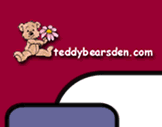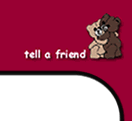Teddy Tutor is here to help! I have some great Tips & Hints for beginners as well as advanced bear makers to help them along with their bear making. They are complied from the beginning of making your Teddy to the very end! I have also listed some Bear Making Terms for those of you who don't know the terminology of bear making. And finally, there is the Teddy Tutor Mailing List. Each month you will receive an email from the Teddy Tutor with a tips & hints on bear-making! You can also submit your own tips & hints for the list by filling out our online form. So come along and join me in the wonderful world of making teddy bears!


If you have a tip or hint you would like to ad please me!
Or you can post it in our Teddy Forum where you can discuss all types of bear topics.
This Tips & Hints were complied by Debbie Zibrik of Dear Bears.
 Tools of the Trade Tools of the Trade
 Layout & Cutting Layout & Cutting
 Pinning, Stitching & Turning Pinning, Stitching & Turning
 Stuffing & Jointing Stuffing & Jointing
 Closing & Finishing Closing & Finishing
 Pulling Your Bear Together Pulling Your Bear Together
 Dyeing your Fabric Dyeing your Fabric


BACK STITCH: Used to hand sew seams. Make a full stitch forward (1/8") and a half stitch back (1/16"). Keep a 1/4" seam allowance.
BURY KNOT: To bury a knot, tie the knot on the surface and run the needle back into the same hole the thread is through. Bring the needle out at least 2" away from the knot, pull the thread tight to pull the knot back through the hole to the inside. Pull the thread tight and cut it close to the fabric. The cut end of the thread will pull itself back under the fabric.
DART: A dart is usually a V shape cut out on a pattern piece. Sew together the two edges of the dar.
GRAIN: Grain runs the length of the fabric on both woven and knit fabrics. It is the same direction as the salvage. On knit back fabrics it is the direction of the rib lines (opposite of the stretch).
JOINT: One joint consists of 2 discs, 2 washers plus 1 pop rivet or 1 cotter pin or a locknut and a bolt (washers are not necessary with locknuts).
LADDER STITCH: Used to close openings after stuffing is completed. From right side of fabric take a stitch through one layer of fabric 1/4" away from the cut edge. Cross over the opening to other edge and take a stitch there. Done properly the cut edge will turn to the inside.
NAP: The direction the fur lays. Run your hand over the fur and you can tell which way the fur lays. Look at the cut edge from the wrong side. The fur will lay past the cut edge in the direction of the nap.
OVERCAST STITCH: Used to finish raw edge of ear and to sew ear to head. Stitch: the thread wraps over the cut edge of fabric.
RUNNING STITCH: Used to gather fabric. Run needle in and out of fabric in a straight line along the seam allowance.
SALVAGE EDGE: The side edge of the fabric. It is often marked with needle holes where the machines holds the edges to finish the fabrics.
SEAM ALLOWANCE: All stitch lines are 1/4" from cut edge unless otherwise indicated.
TAILOR TACKS: Thread tails used to locate the position of eyes, ears etc. From the OUTSIDE OF FABRIC take 1 stitch at location mark leaving 3-4" of loose thread tails on both ends of the stitch.
Big THANKS goes to Spare Bear Parts for these terms. If you have any more that you think I should have I would love to hear from you, just email me at


---compiled by Barb Lawrence
Any time words or phrases have a multitude of interpretations, there is confusion. In our Teddy Bear world, artist is used to indicate the person who makes a bear. To some artist means the person also designed the pattern. To others artist means the person who made the bear, regardless of who made the pattern/design. Artist bear has also been used when referring to teddy bears designed by a named individual but made by a manufacturing facility. Are you confused yet?
There’s a designer, a creator, an artist behind most everything in life except those things in nature. Perhaps we are better defining the bears themselves than labeling those who had a part in their creation. In an attempt to explain the often different meanings of commonly used phrases we present the following:
Artist Original Teddy Bear
The design (pattern) and the teddy are made solely by the same person regardless of the number of bears derived from that design.
Artist Prototype
1. Artist model used as a standard to which others of the edition are compared.
2. The first bear from a new design. Others may not look like the first one if the designer wants a different look.
Artist Bear
1. A bear made entirely by the individual who designed the pattern.
2. Often used in advertising manufactured bears to enhance their desirability.
Artist Designed Teddy Bear
A bear designed by the artist of record however the bear may be made:
1. By the person who designed the bear.
2. With the help of others employed by the artist or
3. Made entirely by others as in the case of a manufacturer producing an artist’s design.
4. Bear made from patterns published in a magazine, book, distributed by a pattern manufacturer, during a class, an artist, on the Internet or provided for hobbyist use.
Artisan Bear
A bear made entirely by one craftsperson other than the person who drafted the design; where the name of the individual who drafted the pattern is often not identified.
Artist & Company
Artist designed bear produced by the artist and others employed by the artist to do such tasks as cutting, pinning, stitching, assembling, stuffing. It is common for the designing artist to make the head by setting the eyes and applying the nose and mouth. A sub category to Artist Designed Bear.
Limited Edition
Indicates pre-determined number of identical bears which are identified by numbers indicating the number each bear is in the edition as well as the size of the total edition.
Manufactured Teddy Bear
A bear made in a commercial manufacturing facility.
Numbered Bear
Bears are numbered sequentially in the order in which they are made.
One-of-a-kind Bear
1. Only bear made from a pattern with no other bear made from that pattern in any fabric or size.
2. Bear is produced only once in a particular fabric, color, size – creating a uniquely finished product.
3. A one-of-a-kind bear should have a distinctive expression and/or shape, AND outfit/accessories that will not be repeated in any other bear.......It should be unique in ALL aspects of its appearance.....not just the pattern it was cut from or the fabric used for its fur.
Note: Some subscribe to the belief that patterns/designs are unlike molds. The creativity is in the interpretation of the pattern, not exclusive to the pattern which remains a separate thing after the bear is made.
Open Edition
One bear design made with no limit to the total number made. May be artist made bear or a manufactured bear.
Pattern
Anything shaped or designed to serve as a guide in making a bear. The resulting bear designs are unlimited and are determined by the materials used and the creativity of the maker(s).
Re-issued Bear
Bear like one previously made by a person or a company
Series
1. Bears of different fabrics made from one pattern.
2. Bears of different sizes made by re-sizing one pattern.
3. Bears with a similar story line or theme.
Signed by the Artist
Hand signed by the person who created the original design.
Reproduction Bear Maker or Reproduction Bear Artist
Someone who makes bears from patterns created by someone else.
Many people feel passionate about terms incorporating the word hand (handmade, hand crafted, hand sewn, hand stitched). These terms imply things done by hand are better than those employing a machine, that more care is taken in the making of the object because it took more time. Those who do fine and work are proud of their work. But fine workmanship is also evident in many machine stitched items. Quality is not necessarily inherent in things made by hand. It it up to the collector to determine the quality of the work in each piece.
Back to Top
|






